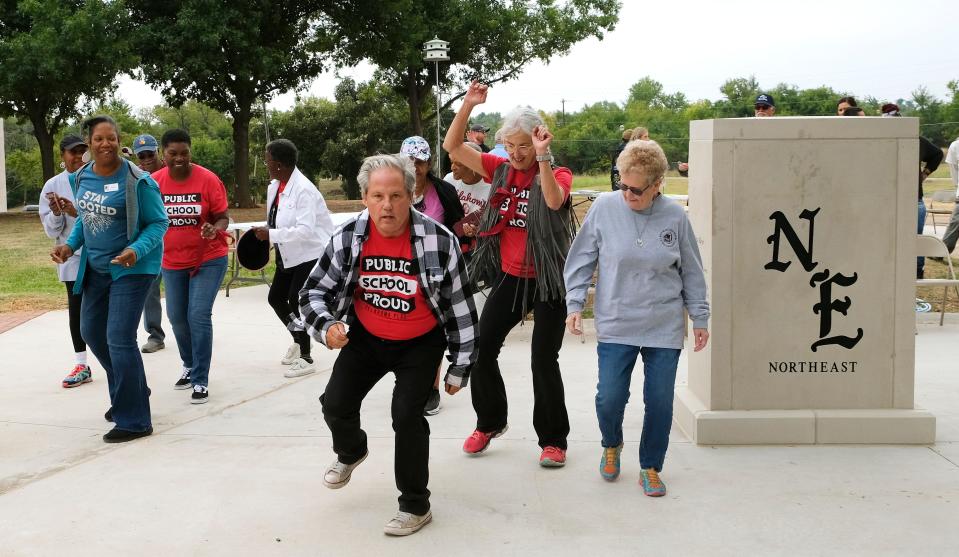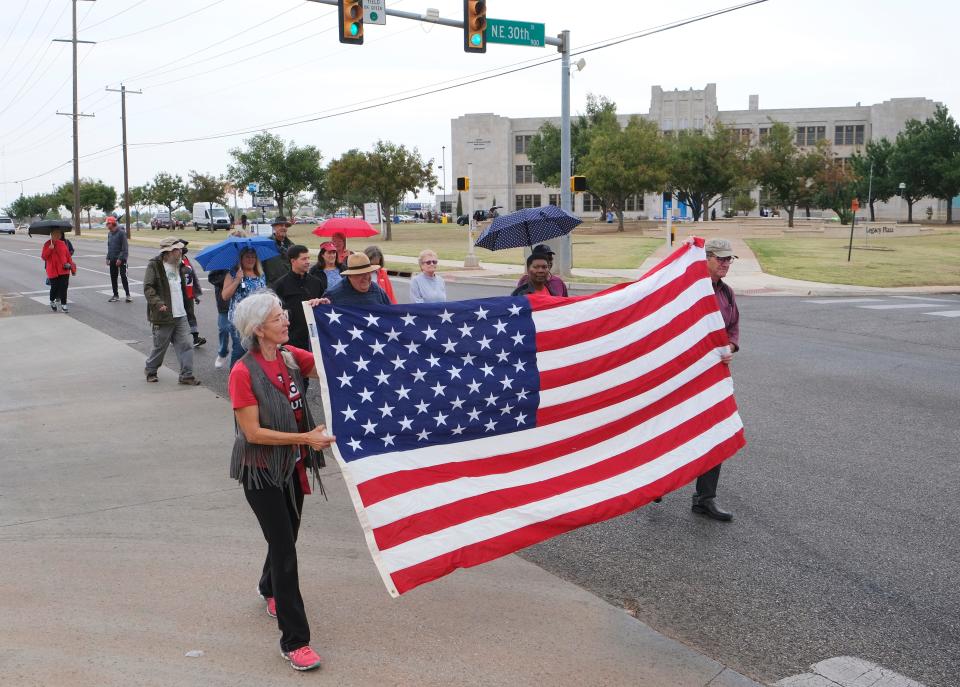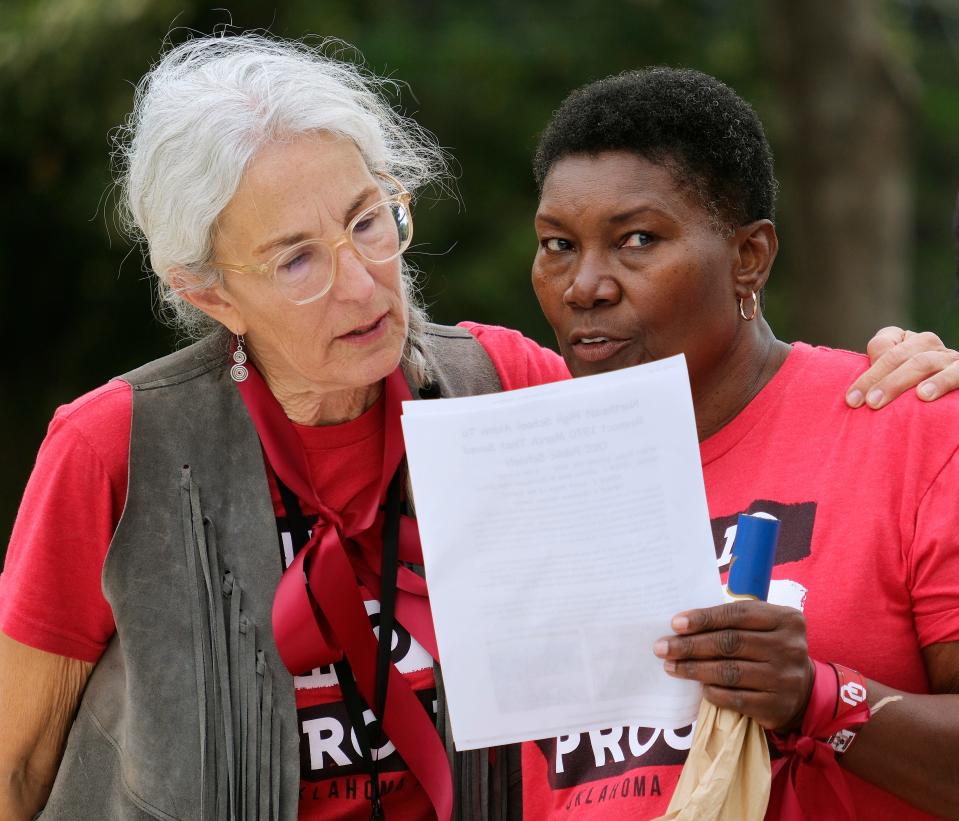Northeast High School alumni recreate historic march in support of 1970 school bond
About 30 Northeast High School alumni re-enacted a historic march in support of a 1970 bond proposal for Oklahoma City Public Schools Friday.
Friday's march began in the parking lot of present-day Classen School of Advanced Studies High School at Northeast, extending to the steps of the Oklahoma state Capitol and ending at the Oklahoma History Center.

The pathway of the march replicates the original demonstration from Jan. 26, 1970, when an estimated 400 Northeast High School students rallied at the Capitol building in support of desegregation at local schools.
Why did Northeast High School students march in 1970?
The late 1960s and early 1970s were a tumultuous time for Oklahoma City Public Schools, as the district wrestled with desegregation amid the civil rights movement. Northeast High School was the first public school in Oklahoma City to desegregate. In 1968, a local optometrist, A.L. Dowell, sued to contest the denial of his son's transfer into the all-white school.
The U.S. Supreme Court had ruled the decades-old "separate but equal" practice of school segregation unconstitutional with the landmark "Brown v. Board of Education" case in 1954, but numerous schools were slow to allow students of color in the same classrooms as white students.
Several alumni from Northeast High School remembered the opposition to integration at the time, which even went so far as attempting to interfere with the tax-supported funding for the entire school district.
"Our principal had daily death threats, we had bomb scares every week, we had the Ku Klux Klan riding on our campus — just everything they could think of to try to scare people and sink this thing," said Terry Fife, who graduated from Northeast High School in 1971. "And so, two years into it, they got another idea, and that was to defeat the millage election."

Why was the 1970 OKCPS school election important?
Locals against integration campaigned to defeat the district's 1970 bond package, which used a property tax millage to fund the schools. If the tax levy didn't pass, the schools would have lost up to $16 million of revenue, potentially shortening the school year by four months.
Northeast High School students in 1970 were worried that if the bond didn't pass, some would be unable to graduate. Disruption of the tax levy was a real possibility, because voter apathy around school elections was high and turnout was historically low. Records show that only an estimated 7,000 people had participated in the previous school bond election.
Brenda Loggins, who was a senior at Northeast High School in 1970, remembers how she and several other Northeast High School students decided to do something about it.
"I was already engaged with a group of students who were student leaders in our schools, student council leaders and class president," Loggins said. "We talked about a lot of things that were happening at that time because it was, you know, the civil rights movement that was going on, so we were very well aware of what was going on around us."
The students rallied on Jan. 26, 1970, and marched to the state Capitol, more than a mile away. The young demonstrators handed out fliers and knocked on doors along the way, encouraging people to vote in favor of the bond.
Was the students' march in 1970 successful?
Northeast High School alumni said they remembered feeling like their actions were having an impact, but were uncertain of what the result would be.
According to The Oklahoman archives, 45,000 people turned out to vote in that 1970 school bond election. Authorities had only expected 12,000 people to show up at the polls. The bond package passed, with thousands of people voting in favor of the tax levy to support continued funding of the district.
Passage of the levy assured $16 million in revenue, about half the amount it took to run the district for a year in 1970. ($35 million was the average budget for the district at that time.)
But there was prolonged backlash to integration. In 1970, enrollment was over 70,000, but the following year saw enrollment begin to drop considerably. By 1981, district enrollment hovered around 40,000 students.
"It was such a painful experience," Fife said. "I mean, people just fought tooth and nail to not be involved in integration. And Edmond was a tiny town back then, and so was Bethany. So was Moore. But these ‘white flight’ patterns? That’s when they began."
What can students learn today from the Northeast 1970 march?
Nowadays, Classen SAS has statistically one of the most diverse student populations in the Oklahoma City Public Schools district. School records from the 2019-20 school year show Classen SAS as 33% Black, 31% white, 16% Hispanic, 12% Asian, 3% Indigenous and 6% multiracial.
More:Classen SAS at Northeast ranked No. 1 high school in Oklahoma
But the fight for progress has not been without its challenges. In recent years, district restructuring saw many schools merge while others closed outright.
Friday's march was preceded by a ribbon-cutting ceremony and monument dedication to the Legacy Plaza. A major source of disagreement was the decision to move Classen SAS into the former Northeast High School building and rename it, but locals are trying to move past the controversy.
With the push for charter schools and the diverting of tax dollars away from public schools, former and current attendees now see a new threat on the horizon.

"I feel like the resistance to integration has morphed, and it looks now like what we’re seeing in the classroom," Fife said. "Fifty-four years later, after integration in Oklahoma City, where are the white students in the public system? They have bailed. And we’ve resegregated. And I just want to call that out."
Related:Participants in OKCPS diversity teacher program find purpose
Loggins, who has retired from a decades-long career as a school nurse, said she took the Northeast High School's motto "Enter to Learn, Go Forth to Serve" seriously. The 1970 march left a profound impact on her life, a feeling of promise and advocacy she said she wants current students to also carry with them today — so much so that she passed a literal baton to younger students Friday afternoon in the Classen SAS parking lot.
"We say our children are the most valuable resource we have today, and we need to come together in unity to create that and embrace them, so that our children feel safe and loved," Loggins said.
Contributing: Staff reporter Nuria Martinez-Keel
This article originally appeared on Oklahoman: Northeast High School alumni reunite for historic 1970 march ceremony

